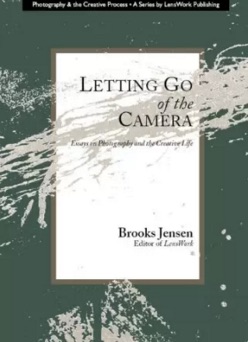“Letting Go of the Camera” is the second Brooks Jensen book that I’ve read. Like the other book, Creative Life in Photography, this is a collection of essays and ruminations. But this time he’s turned his attention more towards the meta of creativity in photography.
He’s touching on a lot of concepts in creativity and photography that, honestly, are what led to my taking up pinhole in the first place. It’s been nearly a decade since I built my first pinhole camera (outside of a photo class) and fell in love with the process. Pinhole for me was a response to the rising trend in DSLR shooting and perfection. At the time, there was so much volume in my shooting. I was filling memory disks like mad. But there was rarely time that I was taking to see. Like a junky, I was voraciously consuming, and the DSLR gave me a fix.
So it is in that spirit that pinhole provided a very needed detox from this habit. Suddenly I wasn’t shooting bursts of photos but rather waiting seconds or minutes for a single exposure. I wasn’t obsessively composing but rather guesstimating based on angles. And I wasn’t filling memory cards but rather mindfully choosing compositions to use precious film on.
The result, for me at least, is that pinhole photography is a much more meditative process than any other form of photography. Several days ago I was at the West Side Market in Cleveland making an indoor exposure that, once corrected for reciprocity, took 18 minutes. That was 18 minutes of observance that I could do. Looking at what to shoot next. Watching the crowds. Observing how people shopped. Seeing. It was 18 minutes of the compassionate observance that David Foster Wallace described in “This is Water”. If I had shot that with a DSLR, I would have cranked up the ISO and opened the aperture enough to get me 1/60th exposure and just moved on.
So what the hell does watching people for 18 minutes have to do with “Letting Go”? Brooks Jensen is asking us to take this time, so that we may be better photographers. He’s not only a photographer, he’s also the publisher of Lens Work magazine, and the host of a number of workshops. In these workshops he’s seen tons of work, but “rarely see photographs that relate to [photographers’] lives, thoughts, feelings, or experiences.” Throughout the book, he’s practically begging us to take a little extra time and look at things differently.
Brooks argues for mastering the craft of photography so that we can let go as, “the true master is one who, indeed, has total control and then lets go and allows an accident to happen.” That’s practically a mantra for excellent pinhole photography. He challenges photographers to photograph what you feel, so that you “let go of yourself and let your subject speak directly to your audience.”
We all know that travel to an unfamiliar place can help spur the creative spirit, but Brooks challenges us to be better in this regard as well, noting that:
It seems that photography presents us with a choice unique in the field of art. We can work to find something new that has never been photographed before and claim it as our unique photographic turf or we can accept the challenge to use our tools as merely tools and realize that the real task of being a photographer is to develop ourselves as conduits for the inspiration that creates artwork. One path leads to tomorrow’s clichés. The other path leads to artwork that seems to endure. One eventually is easy; one is profound.
Brooks absolutely pulls no punches in this regard, also noting that “a great deal of what passes for fine art photography today is not based on vision, talent, or craft; it is based simply on access.” This is a notion that I identify with strongly, and am also toiled by. In our daily lives, hustling about with work and family duties, it can be extremely hard to develop a vision in the seemingly mundane.
However Brooks too understands this struggle, and provides guidance there. Noting examples such as Sudek and Wynn Bullock as great examples of photographers that have realized that “the key is to integrate our art into our life, not the other way around.” Even so, shooting over and over the same areas of our lives can be drivel, right? But no, says Brooks, noting that “Weston took 29 photos of peppers before he finally took his famous Pepper No. 30, and he may have taken many more afterwards.” Brooks expands to note that:
The paradox is simply this: repetition of what has already been done is a useful technical exercise but rarely produces artwork of merit. Repetition of your own creative vision however, leads to refinement, increased depth and sensitivity, and generally does produce better artwork.
It’s that refinement of craft that he’s really driving at. It’s this level of dedication to a topic, and staying to what you know, that is so readily apparent in the wonderful collection that Andy Adams curated in “Looking at the Land”.
There’s so much more to this book then I could possibly cover here. Brooks has been through the ups and downs of a photographic career that has spanned just about every perspective in photography, and has done an excellent job of compiling the many perspectives that come with that career. This is a great read for any photographer – pinholer or not. I encourage you to give it a read – it’s an easy and accessible one – and pursue your photography with increased passion and mindfulness.
“Letting Go of the Camera” is available at Amazon ($5.95 Kindle edition/other formats available)
